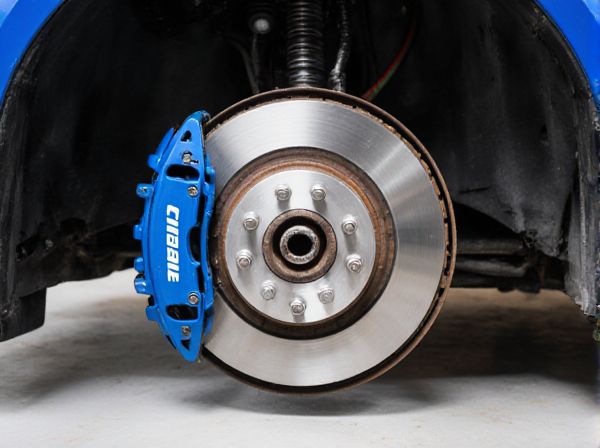
Photo illustration: Floating Calipers vs Opposed-Piston Calipers
Floating calipers provide efficient braking by sliding on pins, allowing one piston to press the brake pad against the rotor while the caliper moves for even pad wear. Opposed-piston calipers feature pistons on both sides of the rotor, delivering balanced pressure and superior braking force with minimal flex. Your choice depends on the desired performance, with opposed-piston calipers favored for high-performance applications due to their enhanced stability and consistent braking.
Table of Comparison
| Feature | Floating Calipers | Opposed-Piston Calipers |
|---|---|---|
| Design | Single piston, moves laterally | Multiple pistons facing each other |
| Weight | Lighter | Heavier |
| Performance | Good for daily driving, adequate stopping power | Superior clamping force, better heat dissipation |
| Cost | Lower cost, simpler design | Higher cost, complex manufacture |
| Maintenance | Easier and cheaper to service | More complex, costlier repairs |
| Applications | Standard passenger vehicles | High-performance, sports, and racing cars |
Introduction to Brake Caliper Types
Floating calipers feature a single piston and move laterally to apply brake force, offering a lightweight and cost-effective solution ideal for most standard vehicles. Opposed-piston calipers, equipped with pistons on both sides of the rotor, provide enhanced clamping force and improved heat dissipation, making them suitable for high-performance and heavy-duty braking systems. Each caliper type plays a critical role in determining braking efficiency, pad wear, and vehicle safety.
What are Floating Calipers?
Floating calipers feature a single piston on one side of the brake rotor, moving laterally to clamp the brake pads against the rotor when activated. This design allows the caliper to "float" and self-adjust for even pad wear, making them lighter and more cost-effective than opposed-piston calipers. They are commonly used in everyday passenger vehicles due to their simplicity and efficient performance in typical driving conditions.
What are Opposed-Piston Calipers?
Opposed-piston calipers feature pistons on both sides of the brake rotor, providing even pressure distribution and improved braking performance compared to traditional floating calipers, which have pistons on only one side. This design enhances stopping power, heat dissipation, and pad wear uniformity, making opposed-piston calipers ideal for high-performance and heavy-duty vehicles. Their rigid mounting and symmetrical force application result in greater stability and responsiveness during braking.
Key Differences Between Floating and Opposed-Piston Calipers
Floating calipers have pistons on only one side and move in and out to clamp the brake rotor, offering a lighter and more cost-effective design ideal for standard braking needs. Opposed-piston calipers feature pistons on both sides of the rotor, providing more even pressure distribution and improved braking performance, making them suitable for high-performance or heavy-duty vehicles. The key differences lie in piston configuration, braking force distribution, weight, and cost efficiency, with floating calipers being simpler and lighter while opposed-piston calipers deliver enhanced stopping power and durability.
Braking Performance Comparison
Floating calipers offer efficient braking performance with a single piston on one side, allowing the caliper to move and apply pressure evenly across the brake pad, which reduces weight and manufacturing cost. Opposed-piston calipers feature pistons on both sides of the rotor, delivering greater clamping force and improved heat dissipation, leading to superior stopping power and pedal feel under high-performance or heavy-duty conditions. The choice between floating and opposed-piston calipers impacts braking responsiveness, thermal management, and overall vehicle control, with opposed-piston systems generally favored for high-performance applications due to enhanced rigidity and balanced pad wear.
Cost and Maintenance Considerations
Floating calipers generally offer a lower initial cost and reduced maintenance expenses due to their simpler design and fewer moving parts. Opposed-piston calipers, while more expensive upfront, provide enhanced braking performance but require more frequent servicing and higher maintenance costs to ensure optimal operation. Choosing between the two depends on balancing budget constraints with long-term performance and maintenance priorities.
Applications in Passenger and Performance Vehicles
Floating calipers, commonly used in passenger vehicles, offer a cost-effective, lightweight solution ideal for everyday driving with moderate braking demands. Opposed-piston calipers, favored in performance vehicles, provide superior braking force and heat dissipation, enhancing stopping power and consistency during aggressive driving or track conditions. The choice between floating and opposed-piston calipers directly influences vehicle braking efficiency, with opposed-piston models preferred for high-performance and heavy-duty applications requiring more precise control and durability.
Pros and Cons of Floating Calipers
Floating calipers offer a lightweight and cost-effective braking solution with fewer moving parts, resulting in easier maintenance and reduced manufacturing complexity. However, they typically provide less consistent clamping force and may experience uneven pad wear compared to opposed-piston calipers, which feature multiple pistons for enhanced braking performance and even pressure distribution. The simpler design of floating calipers can lead to increased rotor wear and diminished heat dissipation under high-performance or aggressive driving conditions.
Pros and Cons of Opposed-Piston Calipers
Opposed-piston calipers provide superior braking performance due to their even pressure distribution on brake pads, resulting in consistent stopping power and reduced brake fade. Their robust design enhances durability and heat dissipation, making them ideal for high-performance or heavy-duty vehicles. However, opposed-piston calipers tend to be heavier, more complex to maintain, and generally costlier compared to floating calipers.
Choosing the Right Caliper Type for Your Vehicle
Choosing the right caliper type for your vehicle depends on factors like braking performance, weight, and maintenance. Floating calipers offer lighter weight and cost-effectiveness, making them ideal for everyday driving and standard vehicles. Opposed-piston calipers provide superior stopping power and heat dissipation, making them suitable for high-performance or heavy-duty vehicles.
 caratoz.com
caratoz.com